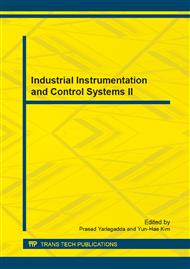p.196
p.200
p.204
p.210
p.216
p.221
p.227
p.232
p.239
A CMOS Temperature Sensor with a Maximum Accuracy of 1.6 °C after One-Point Calibration
Abstract:
This paper presents a time-domain CMOS oscillator-based temperature sensor with one-point calibration for test cost reduction. Compared with the former CMOS sensors with linear delay lines, the proposed work composed of a temperature-to-pulse generator with adjustable time gain and a time-to-digital converter (TDC) can achieve lower circuit complexity and smaller area. A temperature-dependent oscillator for temperature sensing was used to generate the period width proportional to absolute temperature (PTAT). With the help of calibration circuit, an adjustable-gain time amplifier was adopted to dynamically adjust the amplified width that was converted by the TDC into the corresponding digital code. After calibration, the fluctuation of the sensor output with process variation can be greatly reduced. The maximum inaccuracy after one-point calibration for six package chips was 1.6 °C within a 0 80 °C temperature range. The proposed sensor fabricated in a 0.35-μm CMOS process occupied a chip area of merely 0.07 mm2, achieved a fine resolution of 0.047 °C/LSB, and consumed a low power of 25 μW@10 samples/s.
Info:
Periodical:
Pages:
216-220
Citation:
Online since:
July 2013
Authors:
Keywords:
Price:
Сopyright:
© 2013 Trans Tech Publications Ltd. All Rights Reserved
Share:
Citation:


